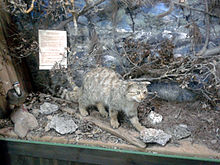| Cretan wildcat | |
|---|---|

| |
| Taxidermied specimen in the Natural History Museum of Mount Diktis, Vidianis Monastery, Lassithi plateau, Crete. | |
| Scientific classification | |
| Domain: | Eukaryota |
| Kingdom: | Animalia |
| Phylum: | Chordata |
| Class: | Mammalia |
| Order: | Carnivora |
| Suborder: | Feliformia |
| Family: | Felidae |
| Subfamily: | Felinae |
| Genus: | Felis |
| Species: | |
| Subspecies: | F. s. silvestris
|
| Trinomial name | |
| Felis silvestris silvestris T. Haltenorth, 1953
| |
| Synonyms | |
| |
The Cretan wildcat is a member of the genus Felis that inhabits the Greek island of Crete. Its taxonomic status is unclear at present, as some biologists consider it probably introduced, or a European wildcat (Felis silvestris silvestris), or a hybrid between European wildcat and domestic cat (F. catus).[1] It was previously considered a separate subspecies of wildcat as Felis silvestris cretensis.[2]
Crete has been isolated from the continent for about 6 million years. Palaeontological data indicate that the island was colonised during the Pleistocene by those mammalian taxa that were able to swim across the sea. Crete's Pleistocene endemic mammalian fauna comprised rodents and herbivores, but remains of predators were not found. Pleistocene mammals died out before the Holocene.[3] More than 9,000 animal bones were excavated at the archaeological site Kavousi Kastro in eastern Crete in the late 1980s that date to the Late Geometric period at about 8th century BC. These faunal remains also included one cat that was identified as a domestic cat.[4] Fragments of a domestic cat were also found at the archaeological site Gortyn dating to the 6th to 7th century AD.[5]
In October 2017, Greek news sites circulated reports that a sheep farmer captured a wild cat after laying traps for a predator that attacked young sheep of his herd. The reports were accompanied by photographs and video footage of the captured animal.[6][7][8][9]
- ^ Kitchener, A. C.; Breitenmoser-Würsten, C.; Eizirik, E.; Gentry, A.; Werdelin, L.; Wilting, A.; Yamaguchi, N.; Abramov, A. V.; Christiansen, P.; Driscoll, C.; Duckworth, J. W.; Johnson, W.; Luo, S.-J.; Meijaard, E.; O’Donoghue, P.; Sanderson, J.; Seymour, K.; Bruford, M.; Groves, C.; Hoffmann, M.; Nowell, K.; Timmons, Z.; Tobe, S. (2017). "A revised taxonomy of the Felidae: The final report of the Cat Classification Task Force of the IUCN Cat Specialist Group" (PDF). Cat News (Special Issue 11): 17−20.
- ^ Wozencraft, C. W. (2005). "Order Carnivora". In Wilson, D. E.; Reader, D. M. (eds.). Mammal Species of the World: A Taxonomic and Geographic Reference. Vol. 1 (3rd ed.). Johns Hopkins University Press. p. 536. ISBN 978-0-8018-8221-0.
- ^ Isaakidou, V. (2005). Bones from the Labyrinth: Faunal evidence for management and consumption of animals at Neolithic and Bronze Age Knossos, Crete. Doctoral dissertation. London: University of London.
- ^ Klippel, W. E.; Snyder, L. M. (1991). "Dark-Age Fauna from Kavousi, Crete: The Vertebrates from the 1987 and 1988 Excavations". Hesperia: The Journal of the American School of Classical Studies at Athens. 60 (2): 179–186. JSTOR 148086.
- ^ Wilkens, B. (2003). "Hunting and breeding in ancient Crete". Zooarchaeology in Greece: Recent Advances. 9: 85–90. JSTOR 40960335.
- ^ "Πιάστηκε Φουρόγατος στον Ομαλό; - Συναγερμός στους επιστήμονες (φωτο)".
- ^ "Αυτός είναι ο 'μυθικός' φουρόγατος που εντοπίστηκε στα Λευκά Όρη". 18 October 2017. Archived from the original on 22 February 2018. Retrieved 18 October 2017.
- ^ Χανιώτικα Νέα (18 October 2017). "Φουρόγατος στα Λευκά Όρη;". Archived from the original on 2021-12-21 – via YouTube.
- ^ Sarantos Nikos (18 October 2017). "Δείτε τον εξαφανισμένο Αγριόγατο - Φουρόγατο της Κρήτης, που προσπαθεί να δραπετεύσει." Archived from the original on 2021-12-21 – via YouTube.